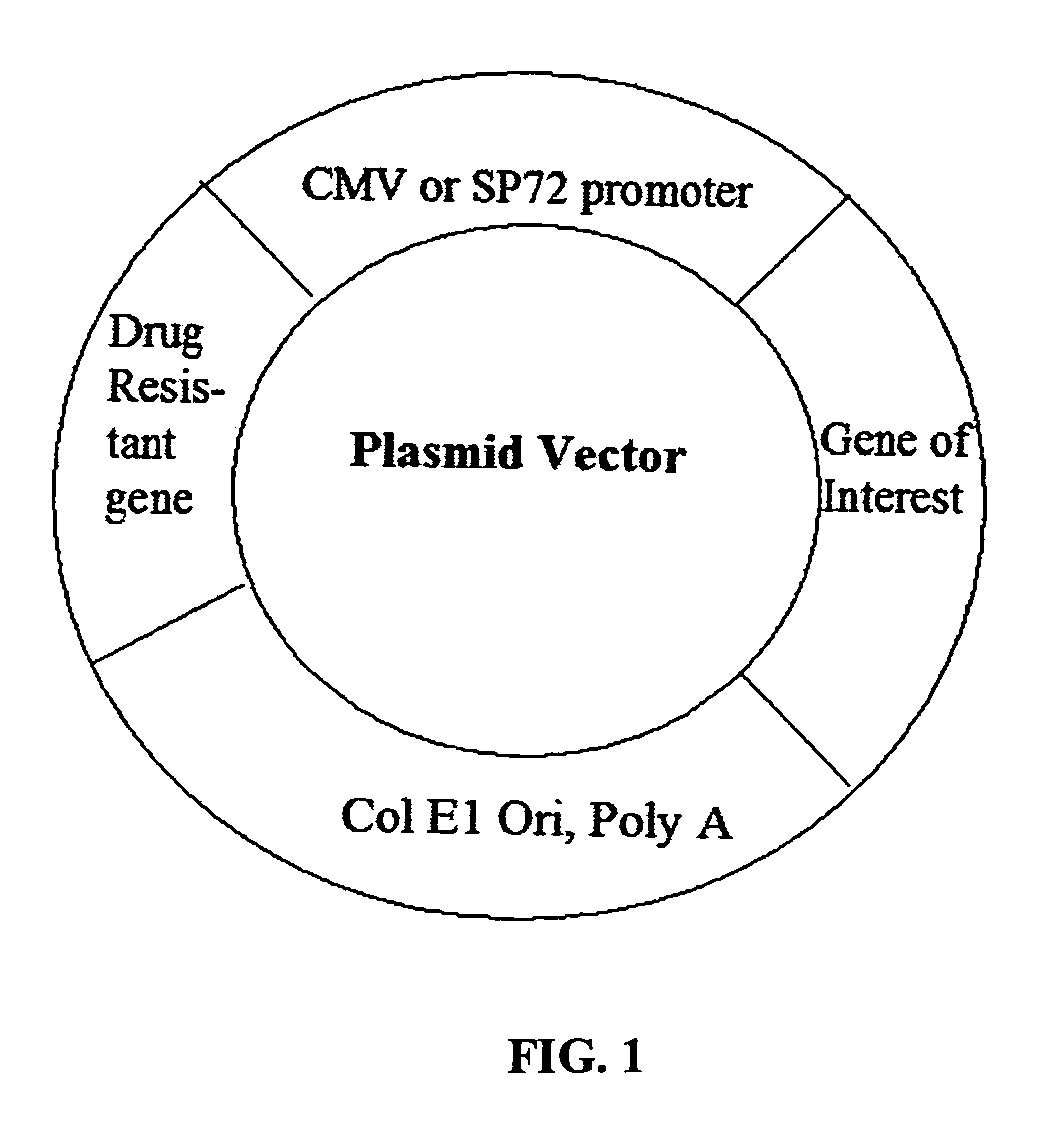Rationally designed and chemically synthesized promoter for genetic vaccine and gene therapy
a gene therapy and genetic vaccine technology, applied in the field of immunotherapy and molecular biology, can solve the problems of ineffective genetic vaccines in primates, transgene expression, and the tendency to silence them
- Summary
- Abstract
- Description
- Claims
- Application Information
AI Technical Summary
Benefits of technology
Problems solved by technology
Method used
Image
Examples
example 1
[0089]To overcome the disadvantages of the CMV promoter, the inventors rationally designed and chemically synthesized an exemplary artificial promoter, designated SP72. SP72 is a 620 base pair DNA fragment. It was built by using twenty 60mer oligonucleotides that underwent several annealing and ligation processes. The full-length promoter was then ligated upstream of a reporter gene in a plasmid vector. The DNA fragment was cloned into a standard plasmid vector, pCMVi (Barry et al., 1995) by replacing the CMV promoter and its intron. The sequence of the SP72 promoter / enhancer (SEQ. ID NO:36) is as detailed below:
[0090]CGGTACATGATGTTCTCGATGCAATATCACGTGAAGGTCAAAAATAGGTCA (SEQ ID NO:1) (Vitamin D binding element, Perlmann et al., 1993) AGGTCACCTCTCTCGGCT (SEQ ID NO:2) (serum response element, Pollock et al., 1991) ATCAAATAAGAGTGTAGGGACGGGAGAGGGGGAAAACAGAACAGAACAGTGCTGACGTCA (SEQ ID NO:3) (CREB / ATF element, Liu and Green, 1990) GCAGGCAGTTG (SEQ ID NO:4) (Myb elemen...
example 2
SP72 Promotor / Enhancer Less the SRE (Serum Response Element)
[0091]The inventors generated a further exemplary promoter / enhancer sequence of SEQ. ID NO:37 using methods as is known to the skilled artisan and described herein, by deleting the SRE of the exemplary promoter / enhancer of SEQ. ID NO:36, thereby obtaining a further promoter / enhancer as detailed below:
[0092]CGGTACATGATGTTCTCGATGCAATATCACGTGAAGGTCAAAAATAGGTCA (SEQ ID NO:1) (Vitamin D binding element, Perlmann et al., 1993) ATCAAATAAGAGTGTAGGGACGGGAGAGGGGGAAAACAGAACAGAACAGTGCTGACGTCA (SEQ ID NO:3) (CREB / ATF element, Liu and Green, 1990) GCAGGCAGTTG (SEQ ID NO:4) (Myb element, reverse, Faisst and Meyer, 1992) CCCTTTGAAAACGTTAACGTTAACGTTCAGCTGCAGCTGCA (SEQ ID NO:5) (AP4 element, Hu et al., 1990) GCTGATTAA (SEQ ID NO:6) (AP1, Yen et al., 1991) TAATTACAGCCAA (SEQ ID NO:7) (CTF-NFI, Gronostajski, 1987) AGGCGCCAAAGGCAACGTTATATGCAAATATGCAAA (SEQ ID NO:8) (Octamer element, Ruvkun and Finney, 1991) TGAGAACAGGGGGGGGGGGCGG (SEQ ID NO:9) ...
example 3
SP72 Promoter Sequence
[0093]In a further embodiment of the invention, the promoter sequence (SEQ. ID NO:35) of SP72 is provided, as detailed below:
[0094]AAATGACATA (SEQ ID NO:40) (α-IFN, Fujita et al., 1985) GGAAAACTGACTCA (SEQ ID NO:23) (AP1, Yen et al., 1991) CAAAGGGAGAAGTGA (SEQ ID NO:24) (α-IFN, Fujita et al., 1985) AAGTGGGACTTTCC (SEQ ID NO:25) (NFκB, Virbasius et al., 1993) AAAGGGCGG (SEQ ID NO:26) (SP1, Kadonaga, et al., 1987) CCAAT (SEQ ID NO:27) (CBP, Graves et al., 1986) TGTGGGCGGGG (SEQ ID NO:28) (SP1, Kadonaga, et al., 1987) CCACCGGTGTTCCTGAAGGGCGCC (SEQ ID NO:29) (TFIIB) TATATAA (SEQ ID NO:30) (TFIID, Breathnach and Chambon, 1981) GGGGGGGCGGGCGCGTTCGTCCTCATTC (SEQ ID NO:31) (Initiator, Smale and Baltimore, 1989) TGGACCGCGTCCGCCCCGCG (SEQ ID NO:32) (AP2, Williams and Tjian, 1991) AGCAGACGTG (SEQ ID NO:33) (downstream element, Burke et al., 1998) GAGCTCTCAGTCTCAGCGATCAA (SEQ ID NO:34).
[0095]Of course, those of ordinary skill in the art would be able to produce other examp...
PUM
 Login to View More
Login to View More Abstract
Description
Claims
Application Information
 Login to View More
Login to View More - R&D
- Intellectual Property
- Life Sciences
- Materials
- Tech Scout
- Unparalleled Data Quality
- Higher Quality Content
- 60% Fewer Hallucinations
Browse by: Latest US Patents, China's latest patents, Technical Efficacy Thesaurus, Application Domain, Technology Topic, Popular Technical Reports.
© 2025 PatSnap. All rights reserved.Legal|Privacy policy|Modern Slavery Act Transparency Statement|Sitemap|About US| Contact US: help@patsnap.com



